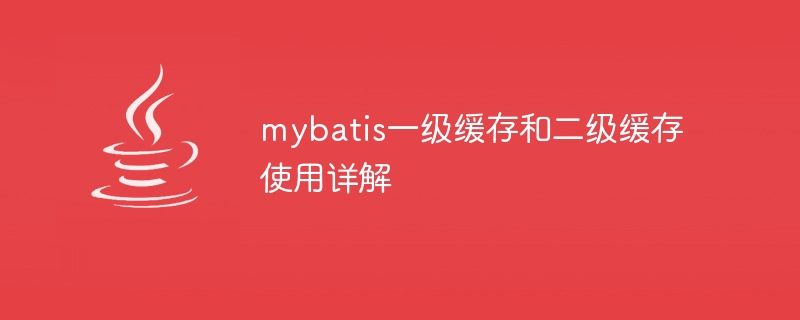Home >Java >javaTutorial >Detailed explanation of the use of mybatis first-level cache and second-level cache
Detailed explanation of the use of mybatis first-level cache and second-level cache
- DDDOriginal
- 2023-08-21 11:53:591156browse
Mybatis first-level cache and second-level cache usage: 1. The first-level cache is the cache mechanism enabled by MyBatis by default. It will first check whether the same query result already exists in the first-level cache of the current thread. If it exists, Directly return the data in the cache instead of sending query requests to the database; 2. The second-level cache is a namespace-based caching mechanism. It will first check whether the same query result already exists in the current namespace second-level cache. If it exists, it will directly return to the cache. data in the database without sending query requests to the database.

MyBatis is an open source persistence layer framework that provides a way to map Java objects to database operations. In MyBatis, first-level cache and second-level cache are two different levels of caching mechanisms, both of which can be used to improve performance.
The first-level cache is the caching mechanism enabled by MyBatis by default. It is thread-based, which means that each thread has its own first-level cache. The working mechanism of the first-level cache is that when performing a query operation, it will first check whether the same query result already exists in the current thread's first-level cache. If it exists, it will directly return the data in the cache without sending a query request to the database. This can reduce the number of database accesses and improve query performance.
The effective scope of the first-level cache is within the same SqlSession. When the SqlSession is closed or any modification operation (insert, update, delete) is performed, the first-level cache will be cleared. Therefore, the first-level cache is suitable for scenarios where the same data is queried multiple times in the same request or transaction. For frequently changing data or multiple concurrent requests, the effect of the first-level cache may not be obvious.
The second-level cache is a namespace-based caching mechanism that can be used across multiple SqlSession. The working mechanism of the second-level cache is that when performing a query operation, it will first check whether the same query result already exists in the second-level cache of the current namespace. If it exists, the data in the cache will be directly returned without sending a query request to the database. This can reduce the number of database accesses and improve query performance.
The effective scope of the second-level cache is within the same namespace. When any modification operation is made to the SqlSession inside the namespace, the second-level cache will be cleared. Therefore, the second-level cache is suitable for scenarios where the same data is shared between multiple SqlSession. For frequently changing data or multiple concurrent requests, the effect of the second-level cache may not be obvious.
In MyBatis, the first-level cache and the second-level cache are independent of each other. They can be used at the same time or separately. The first-level cache is enabled by default and does not require configuration, while the second-level cache needs to be configured in the MyBatis configuration file.
To configure the second-level cache, you need to add the following configuration to the Mapper configuration file:
<cache type="org.apache.ibatis.cache.impl.PerpetualCache"/>
This turns on the default second-level cache, which uses PerpetualCache as the cache implementation class. If you need to use other cache implementation classes, you can customize the implementation class and specify it in the configuration file.
It should be noted that the life cycle of the second-level cache is the same as the life cycle of the application, that is, it is created when the application starts and is destroyed when the application is closed. Therefore, if you use MyBatis in a distributed environment, you need to consider the cache synchronization and update mechanism to avoid data inconsistency.
Summary
The first-level cache and the second-level cache are caching mechanisms used to improve query performance. The first-level cache is based on threads and is suitable for scenarios where the same data is queried multiple times in the same request or transaction; while the second-level cache is based on namespace and is suitable for scenarios where the same data is shared between multiple SqlSession. Depending on the specific application scenarios and requirements, you can choose to use first-level cache, second-level cache, or both at the same time.
The above is the detailed content of Detailed explanation of the use of mybatis first-level cache and second-level cache. For more information, please follow other related articles on the PHP Chinese website!
Related articles
See more- An in-depth explanation of the Mybatis series (4)---detailed configuration of typeAliases aliases (mybatis source code)
- Two methods of sql splicing for MyBatis fuzzy query
- How does html reference JavaScript? Four ways to introduce js paths in html
- Is Java language difficult to learn?
- What are the methods to convert string to date in java

